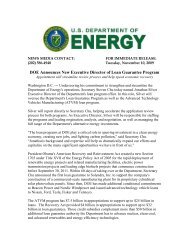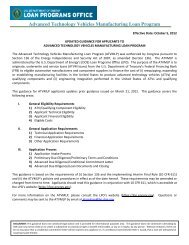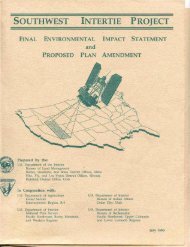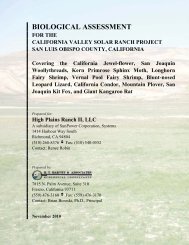Bureau of Land Management's Decision Record and Environmental
Bureau of Land Management's Decision Record and Environmental
Bureau of Land Management's Decision Record and Environmental
Create successful ePaper yourself
Turn your PDF publications into a flip-book with our unique Google optimized e-Paper software.
Jersey Valley Geothermal Development Project<br />
<strong>Environmental</strong> Assessment: NV063-EAO8-091<br />
responsibility by both the federal <strong>Environmental</strong> Protection Agency (USEPA) <strong>and</strong> the State <strong>of</strong><br />
Nevada to regulate air pollution <strong>and</strong> emissions <strong>of</strong> air pollutants in all areas <strong>of</strong> the State, other<br />
than Clark <strong>and</strong> Washoe Counties.<br />
Air quality in <strong>L<strong>and</strong></strong>er <strong>and</strong> Pershing Counties has been designated as “attainment/unclassified”<br />
(which means it either meets, or is assumed to meet, the applicable federal ambient air quality<br />
st<strong>and</strong>ards) for all st<strong>and</strong>ard (“criteria”) air pollutants [ozone, carbon monoxide, nitrogen dioxide,<br />
sulfur dioxide, inhalable particulate matter (PM<br />
<strong>and</strong> hydrogen sulfide] (U.S. EPA 2009).<br />
10<br />
), fine particulate matter (PM<br />
25<br />
), lead particles<br />
Neither the Jersey Valley Unit Area nor the transmission line corridor are located in or adjacent<br />
to any m<strong>and</strong>atory Class I (most restrictive) Federal air quality areas, U.S. Fish <strong>and</strong> Wildlife<br />
Service Class I air quality units, or American Indian Class I air quality l<strong>and</strong>s.<br />
3.2.2 <strong>Environmental</strong> Consequences<br />
3.2.2.1 Proposed Action<br />
The primary pollutant <strong>of</strong> concern during construction activities would be particulates in the form<br />
<strong>of</strong> fugitive dust. Fugitive dust would be generated from earth-moving activities <strong>and</strong> travel on<br />
unpaved roads during power plant, drill pad, pipeline, road construction <strong>and</strong> drilling activities.<br />
Based on implementation <strong>of</strong> environmental protection measures specified by Ormat, water <strong>and</strong><br />
gravel would be applied to the ground as necessary to control dust (see Section 2.1.11). Each <strong>of</strong><br />
the well pads, access roads <strong>and</strong> the power plant site would be surfaced with aggregate to<br />
minimize dust. This would minimize fugitive dust emission during construction activities.<br />
The dust which could be generated when drilling with air would be controlled by a<br />
separator/muffler, <strong>and</strong> only the air <strong>and</strong> water vapor would be discharged to the air.<br />
An NDEP-BAPC Surface Area Disturbance Permit, documenting the areas <strong>of</strong> proposed<br />
disturbance <strong>and</strong> the best practical dust control methods to be used, will be required for the<br />
Project because the surface disturbed by the Project would be greater than 5 acres. Best practical<br />
dust control methods applicable to the project activities include use <strong>of</strong> water trucks to spray<br />
water on disturbed areas on a regular basis; pre-watering <strong>of</strong> areas to be disturbed; graveling <strong>of</strong><br />
roadways, storage areas <strong>and</strong> staging areas; posting <strong>and</strong> limiting vehicle speeds to 10 to 15 miles<br />
per hour, <strong>and</strong> use <strong>of</strong> wind fences to reduce wind impacts. Implementation <strong>of</strong> the applicable best<br />
practical dust control methods, through compliance with the Surface Area Disturbance Permit,<br />
would minimize fugitive dust emissions during construction, operation <strong>and</strong> decommissioning <strong>of</strong><br />
the project.<br />
Combustion emissions <strong>of</strong> criteria air pollutants [nitrogen dioxide (NO<br />
2), sulfur dioxide (SO<br />
2),<br />
carbon monoxide (CO), <strong>and</strong> particulate matter less than or equal to 10 microns in diameter<br />
(PM<br />
)], criteria air pollutant precursors [volatile organic compounds (VOCs)] <strong>and</strong> air toxics<br />
10<br />
(small quantities <strong>of</strong> diesel PM, acetaldehyde, benzene, <strong>and</strong> formaldehyde) would be released<br />
during well drilling <strong>and</strong> construction activities from the diesel engines used.<br />
- 37 -







